Across Wisconsin, first-crop alfalfa provides excellent forage quality and yield if protected from insect pests and harvested at the appropriate time. Alfalfa is a notoriously “buggy” crop, but most insects in the field are beneficial to the ecosystem. Very few insects are pests capable of economic damage.
Why scout for insect pests?
On average, we lose 20% of our crop yield globally to insect pests. To reduce potential losses, the first step of a successful insect management program is scouting. Understanding if your pests have reached economically damaging levels is important prior to choosing a management strategy.
Economic thresholds refer to the pest density or level of damage at which a control measure is needed to prevent economic loss. These thresholds are both insect- and crop-specific. When you spray an insecticide on alfalfa, you may lose the biocontrol protection from beneficial insects – the predators and parasitoids already in your system.
Economic thresholds refer to the pest density or level of damage at which a control measure is needed to prevent economic loss.
Consult economic thresholds when deciding whether to control an insect pest. An economic loss would occur when the cost of the insect damage (e.g., reduced yield or quality) exceeds the cost of control.
Beneficial insects
Remember, not all insects are pests! Numerous beneficial insects like pollinators, parasitoids, and generalist predators live in our croplands and provide ecosystem services that are valuable for agricultural production. Spraying unnecessary insecticide can harm pollinators and natural enemies of alfalfa pests. When insecticides are warranted, choose narrow-spectrum products and apply according to label instructions. Misapplication of insecticides (e.g., incorrect rate, poor coverage) can lead to poor pesticidal activity and ultimately increase spray events, harming beneficial insect populations.
Alfalfa insect scouting calendar
Different insects become problematic at different times in the growing season. Figure 1 is a generalized calendar for insect pests on Wisconsin alfalfa. Narrow lines indicate field damage is less likely to be detected, while wider lines show times of the year when damage might reach an economic threshold.

Insect development is temperature-dependent. Monitoring degree-day accumulation is a more precise way to scout for insects. Pest-specific degree day models predict important events in the insect’s life cycle (e.g., egg hatch, larval stages) based on heat accumulation.
First-crop insect scouting in alfalfa
Alfalfa weevil scouting
Alfalfa weevils are early-season pests that feed on alfalfa leaves and may severely damage first-crop and second-crop alfalfa fields by reducing yield and forage quality. Alfalfa weevil adults are small (about ¼ inch), gray-brown snout beetles with a distinct V-shaped strip down the center of the thorax and abdomen (Figure 2). The larvae are legless, green grubs (about 3/8 inch) with a white stripe along the center of their back and a shiny black head capsule.
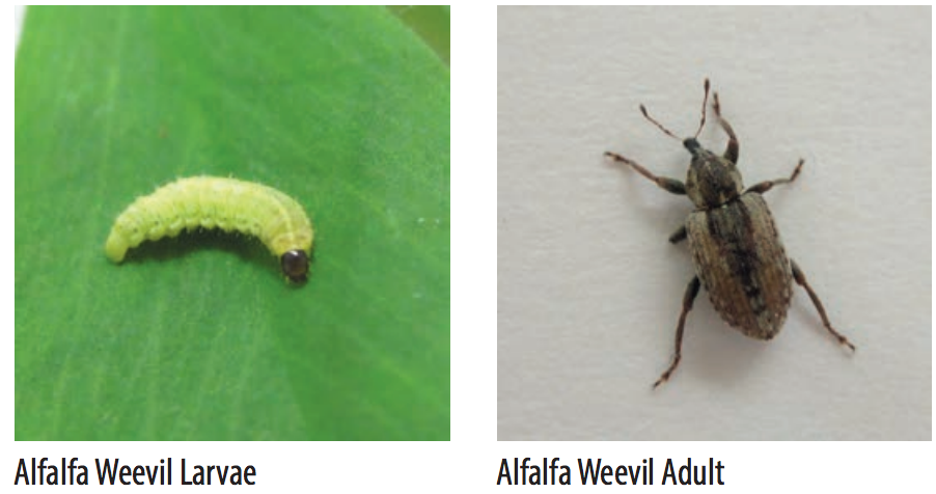
Photos by Bryan Jensen, UW-Madison
In early spring, adult alfalfa weevils emerge from overwintering sites and migrate to alfalfa fields to lay eggs in alfalfa stems. The eggs hatch into larvae, which feed on alfalfa foliage (Figure 3). Crop damage is primarily caused by alfalfa weevil larvae.
Start spot checking your alfalfa fields at 300-degree days (sine base 48°F) for newly hatched larvae and early signs of feeding. Concentrate scouting on warmer south facing slopes or sandy knolls where leaf pinhole feeding is likely to appear first.
Treatment decisions should not be made based on sweep net counts, but these counts are useful to identify the size and number of larvae present in the field (Figure 4).
Using a standard 15-inch net, walk a M-shaped pattern in the field and take two sets of 50 sweeps for a total of 100 sweeps. An abundance of first and second-instar larvae signals the population is young and feeding damage is likely to increase as the larvae mature.
Check out this video for instructions on how to use a sweep net.
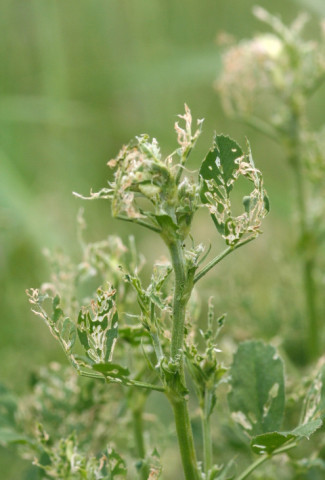
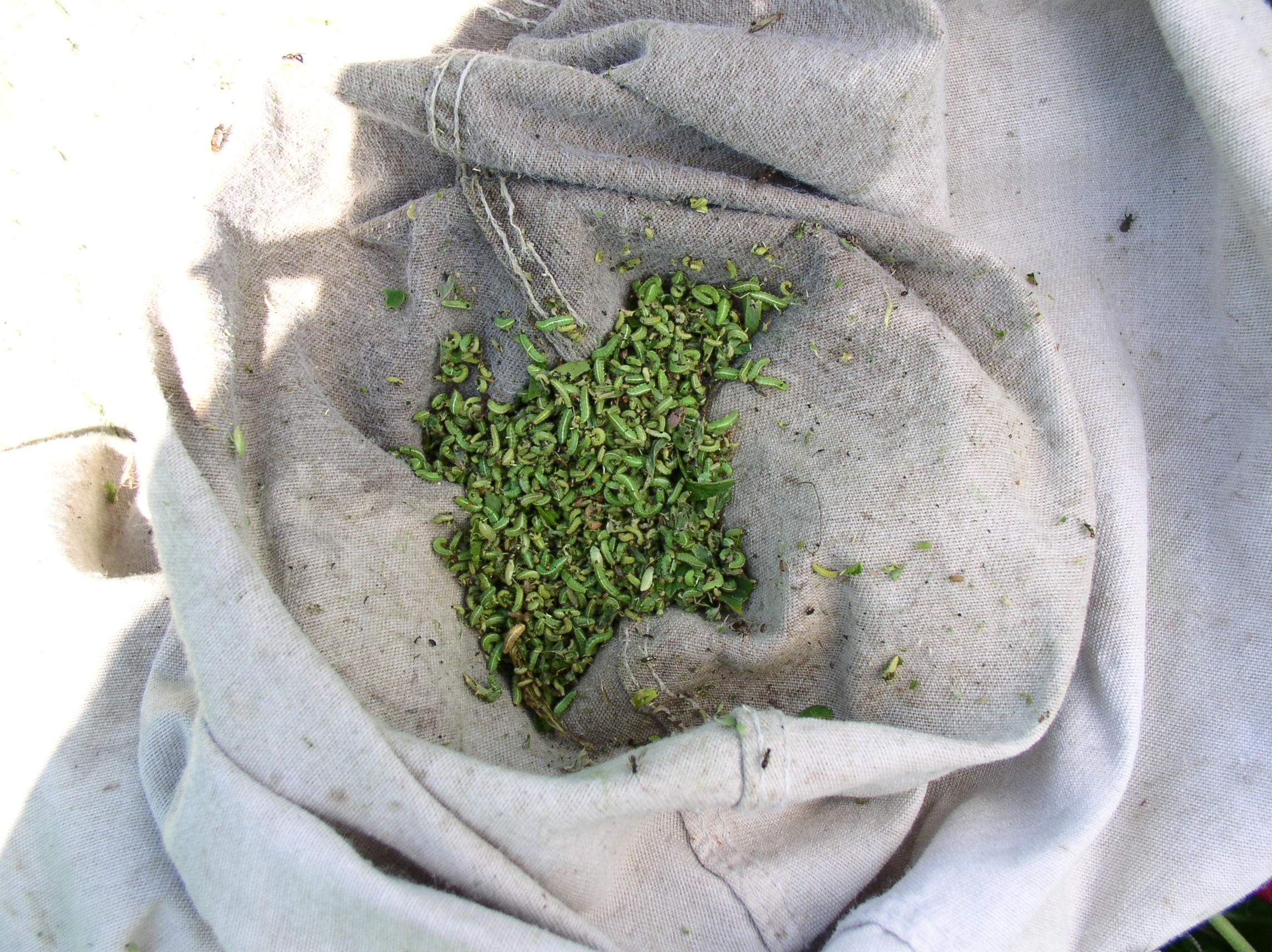
Assess tip feeding for more accurate scouting. Walk a M-shaped pattern and hand-collect alfalfa stems or examine the tops of 50 alfalfa stems at random. Closely inspect each stem for signs of weevil feeding. Count all the stems with feeding and divide by 50 to determine the percentage of tip feeding.
Insecticide applications may be warranted if alfalfa weevil tip feeding damage exceeds the 40% threshold for first-crop alfalfa and 50% threshold for second-crop regrowth.
Chemical treatment is often unnecessary if the field is less than seven days from the scheduled harvest date, since harvesting alfalfa is an excellent cultural control method for alfalfa weevil. Always follow the pesticide’s pre-harvest interval. Spraying unnecessary insecticide can harm natural enemies of alfalfa weevils and other alfalfa pests.
Check regrowth 4-5 days after cutting, take a sweep net sample to confirm larvae are present, and collect or examine a total of 50 stems to assess feeding injury. You should scout second-crop regrowth thoroughly to ensure weevils are not feeding on new stems or crown buds.
Find more information about alfalfa weevil in Wisconsin in Managing Alfalfa Weevil in Wisconsin Alfalfa Fields – Crops and Soils.
Pea aphid scouting
Pea aphids congregate on alfalfa leaves and stems and suck out plant sap. Economic damage from pea aphid feeding is uncommon, but excessive populations can cause yellowing and stunting of alfalfa. Damage may be more severe in dry seasons when soil moisture is below the plant’s requirements. Third and fourth cuttings have the greatest potential for economic damage.
Pea aphids are green or rose-colored, soft-bodied insects with a pair of “tailpipes” (cornicles) protruding from the end of the abdomen (Figure 5). Pea aphid adults (about 1/8 inch) can be winged or unwinged. Nymphs resemble adults but are smaller. In Wisconsin alfalfa, pea aphids overwinter as eggs, hatch in early spring, and reproduce rapidly.
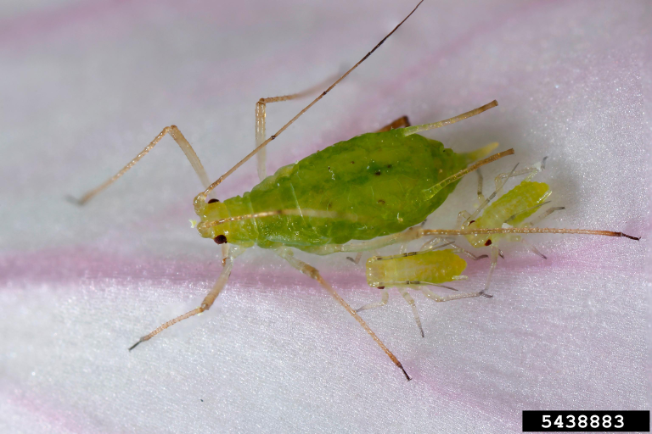
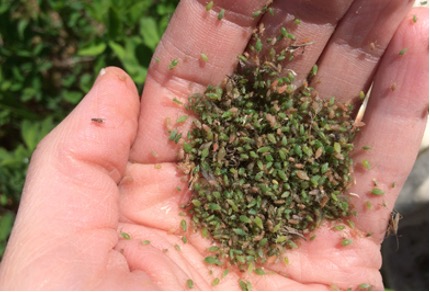
Using a standard 15-inch net, walk a M-shaped pattern in the field and take five sets of 20 sweeps for a total of 100 sweeps. Count the total number of aphids and divide by 100 to determine the average number of aphids per sweep (Figure 6). Diseased or parasitized aphids in the capture indicate the presence of natural enemies in the alfalfa field.
Cultural controls like intense cutting schedules and biological controls including pathogens, predators, and parasitoids can effectively control aphids.
Insecticide applications may be warranted if the average pea aphid population is greater than 100 per sweep and plants show signs of damage. Spraying unnecessary insecticide can harm natural enemies of aphids and other alfalfa pests. This may result in a pest resurgence as aphid populations recover more quickly than natural enemies (e.g., lady beetles, lacewings, damsel bugs, parasitic wasps).
Chemical treatment is often unnecessary if the field is less than seven days from the scheduled harvest date, since harvesting alfalfa is an excellent cultural control method for aphids. Always follow the pesticide’s pre-harvest interval.
Plant bug scouting
The alfalfa plant bug and tarnished plant bug are the two plant bugs that primarily feed on alfalfa in Wisconsin. Plant bugs damage alfalfa by extracting sap with their piercing-sucking mouthparts and injecting toxic saliva into the plant. The toxin inhibits cell expansion in the plant and causes stippled and crinkled leaves or stunts alfalfa growth. Both nymphs and adults can damage alfalfa.
Adult plant bugs have wings and a “V” shape near the middle of their backs. Nymphs are green, smaller, and lack fully developed wings. The adult alfalfa plant bug (3/8 inch long) is light green with a dark spot on each side of the thorax and greenish-brown wings (Figure 7). The adult tarnished plant bug is smaller (1/4 inch long) and has dark markings on a tan body with greenish-brown wings (Figure 8).
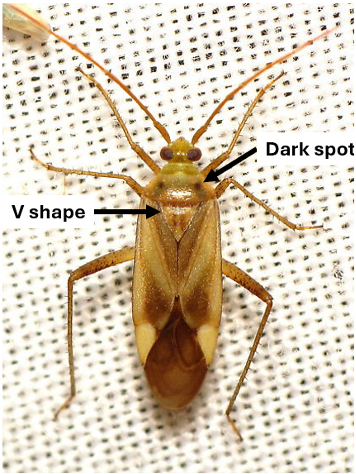
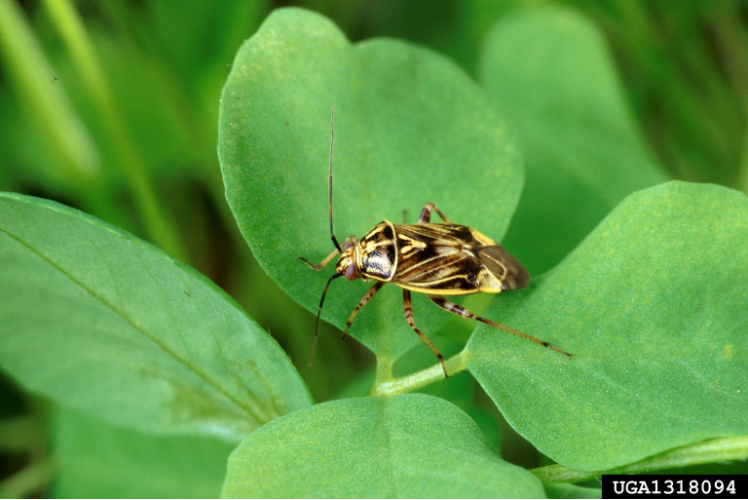
Malformed leaves may be present in the absence of plant bugs. Scout fields for insects to determine if symptoms are the result of plant bug feeding or environmental conditions.
Using a standard 15-inch net, walk a M-shaped pattern in the field and take five sets of 20 sweeps for a total of 100 sweeps. Count the total number of plant bug nymphs and adults (alfalfa plant bug and tarnished plant bug) and divide by 100 to determine the average number of plant bugs per sweep.
On alfalfa less than three inches tall, treat the field if there are three or more plant bugs per sweep. On taller alfalfa, treat if there are five or more plant bugs per sweep.
Do not use insecticides if the field is less than seven days from the scheduled harvest date. Always follow the pesticide’s pre-harvest interval. Early cutting is an effective cultural control method for plant bugs.
Spittlebug scouting
Spittlebugs are common in alfalfa, but damage from spittlebugs in alfalfa is uncommon. Meadow spittlebugs overwinter as eggs and nymphs hatch in the spring. The small, wedge-shaped pale orange to yellow nymphs form a spit-like mass in leaf axils or in clumps of new growth at the tip of stems (Figure 9). The spittle masses protect nymphs from predators and desiccation until they emerge as larger, light green nymphs late in the first crop or early in the second crop (Figure 10).
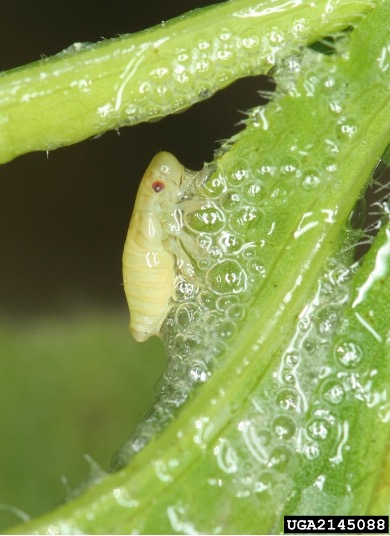

Adult meadow spittlebugs (about 3/8 inch long) have fully developed wings and can be various shades of brown with occasional mottling (Figure 11). There is one generation of meadow spittlebugs a year, so the window for crop damage is small.
Nymphs and adults utilize piercing-sucking mouthparts to consume plant sap. Symptoms include stunting and wilting of plants. Yellowing is not a symptom of spittlebug feeding.
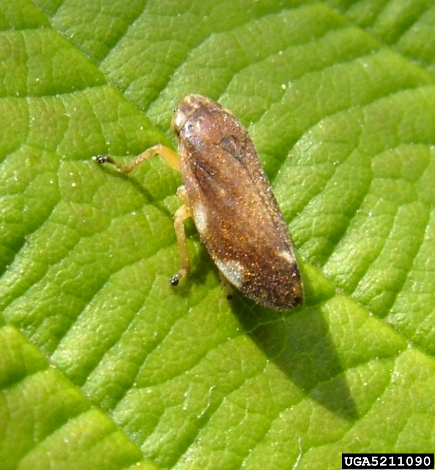
Treatment may be warranted if an average of one spittlebug per stem is observed. Spraying unnecessary insecticide should be avoided, since they can harm natural enemies of spittlebugs and other alfalfa pests.
Additional Resources
Current Wisconsin pest management recommendations
Consult Pest Management in Wisconsin Field Crops (A3646): A guide to managing weeds, insects, and diseases in corn, soybean, forages and small grains for current management recommendations for alfalfa pests.
Consult the Wisconsin Field Crop Scouting Manual, Chapter 2: Alfalfa for a scouting calendar and insect profiles.
Insect pest text alerts
Sign up for the Bick Lab’s collaborative Insect Pest Text Alert service with Extension and WI DATCP to find out what insect pests are emerging and active in fields near you.
References
Generalized Calendar of Events for Insects and Disease in Wisconsin- Alfalfa
Wisconsin Field Crop Scouting Manual, Chapter 2: Alfalfa
Managing Alfalfa Weevil in Wisconsin Alfalfa Fields – Crops and Soils
Alfalfa Weevil Thermal Model – AgWeather
Plant Bugs | Crop Protection Network
Meadow spittlebug | Crop Protection Network
Alfalfa insects: What to look for and how to scout | UMN Extension
Updated: May 1, 2025
Reviewed by: Emily Bick, Marta Kohmann


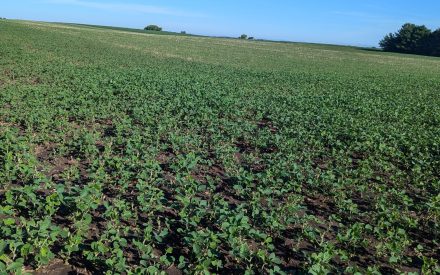 Early season insect scouting in soybean
Early season insect scouting in soybean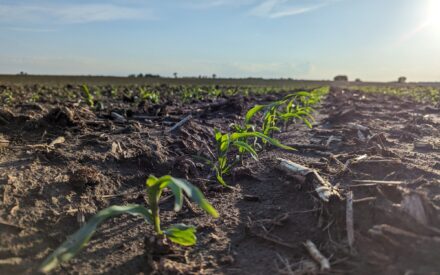 Early season insect scouting in corn
Early season insect scouting in corn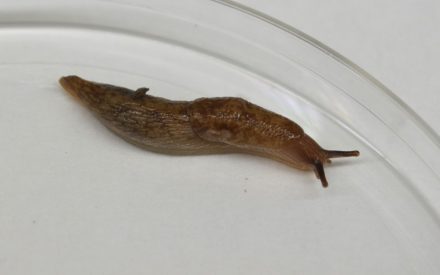 Managing Slugs in Wisconsin Field Crops
Managing Slugs in Wisconsin Field Crops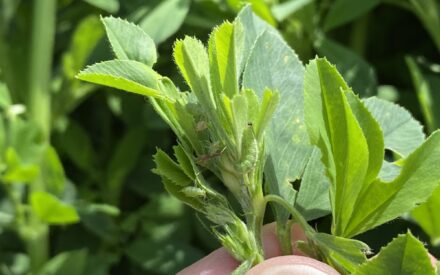 ▶ Forage Insect Pest Update
▶ Forage Insect Pest Update


